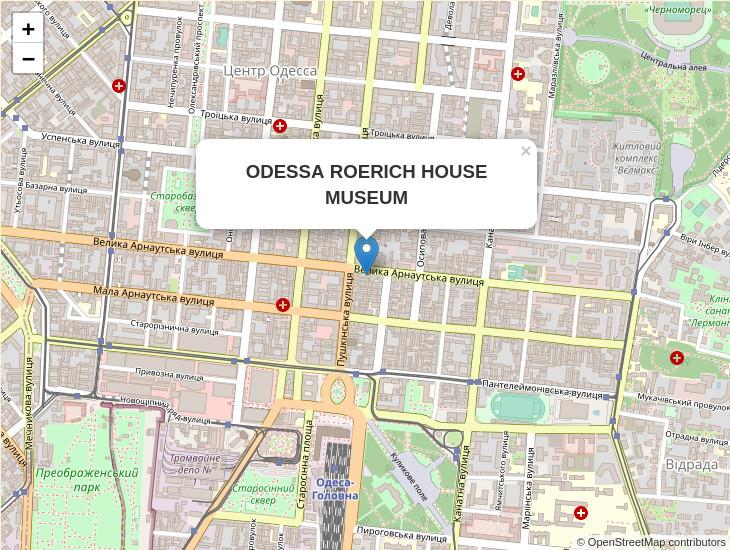HALL OF TEACHERS OF MANKIND

The hall of the Teachers of mankind reflects the idea of the unity of all religions, the one source of their origin. The Roerichs were profoundly convinced that the Teaching of the evolution of world and man (cosmogenesis and anthropogenesis) is the basis of all religions. The distinctions exist only in formal or ceremonial worship, i. e. exoteric cult. The series «Banners of the East» had been accomplished in 1925. It consists of 19 painting dedicated to saints, spiritual workers, founders of worlds religions. Nicholas Roerich showed in his painting the very Slavic idea of «Sophia-God’s Wisdom», «collegiality», as a philosopher of the «silver age» V. Solovyov call it, and F. M. Dostoevsky called it «All-Humanity». «Moses the Leader» (1925) — the biblical prophet, the author of the Pentateuch. Helena Roerich wrote about him: «Moses truly was a great leader,... he was the creator of Israeli people». «Mohammed on Mount Hira» (1925) — the founder of Islam and the first Islamic community. Nicholas Roerich wrote in his diary: «The same, of the Old and New Testament, Archangel Gabriel on mount Hira indicated to Mohammed to start teaching”. “Confucius” (1925) — a philosopher,
who founded the ethical and political teaching in ancient China. «Lao Tzu» (1925) — a founder of philosophical teaching of Daoism. Nicholas Roerich explained «that Lao Tzu is depicted (in his painting ..) on a holy black ox on his way to Tibet». The painting of the great catholic «St. Francis of Assisi» (1932) can be considered as a part of triptych. In its center one can see the painting «Madonna Oriflamma» with the Banner of Peace and Culture in Her hands. The right part is represented by the painting «St. Sergius», who holds the restored Temple of Spirit in his hands, and the landscape behind him joins the one in the painting «St. Francis». The Christian series is represented by the following Nicholas Roerich’s paintings: «Christ» (1933), «Chalice of Christ» (1925), «Signs of Christ» (1924), «Temptation of Christ» (1932) and «Christ’s Descent into Hell» (1933). Svetoslav Roerich has paid tribute to the Son of God — Christ — in the paintings «Love thy neighbours as yourselves», «Pieta», having embodied there His testament: «Greater love has no one than this, that he lay down his life for his friends».

Images of the Teachers of Buddhism are represented by the reproductions of Svetoslav Roerich’s and Nicholas Roerich’s paintings, by the original icons (tankhas) in the style of the Mongolian painting (XIX c.), the small sculptures of Buddha (XIX c.) and the Gods from the Buddhist pantheon — Avalokiteshvara (the patron of Tibet, XIX c.), Kubera (the patron of the various riches, XIX c.) and by the ceremonial objects. The female gods — White and Green Tara are depicted on the canvas in the Mongolian-styled painting (XIX c.). «Buddha the Conqueror» (1925) by Nicholas Roerich shows a culmination of the spiritual gain of man, who became Buddha (sans. «enlighted», «lit up with the highest wisdom» ). Nicholas Roerich
called Buddha the «teacher of life», «lion of fearlessness»; and wrote «the time has come when the image of Buddha — the Great Community Man, who taught against property, against murder, drink and excesses — is emerging out of the gilding of the idol. A powerful image emerges and calls to the soul-searching, labour and learning». Religious tradition of Hinduism is represented by the Nicholas Roerich’s paintings «Krishna», «Bhagavan» (Ramakrishna, 1945), and the devotional sculptures of Krishna and his spiritual woman reflection Radha. An original traditional icon on canvas shows God Krishna as a Cowherd with Gopis (cowherd girls).

Nicholas Roerich had dedicated many of his works both visual «The Mother of the World» (1924) and literary works to this Divine Image: «The image of the Mother of the World can be found all over the East and the West, and words addressed to this High Spirit are full of deep meaning. The Face is often concealed, and under the folds of the veil shining with the squares of perfection the Common Image of the Mother of All-Being seems to appear». Triptych «Fiat Rex» (1931) can be considered as the culmination of paintings of Nicholas Roerich. The Master is depicted in the shine of Glory, in all his spiritual power of Light. In his hands he holds the Stone, which description can be found in the legends of any nation. According to them, the Stone came to Earth from the constellation Orion in ancient times. At the place of the impact Shambhala, the Stronghold of Teachers of Knowledge and Light was founded. To this day the Stone remains in the Stronghold and connect the worlds of Earth and the Cosmos. The fragment of the Stone was possessed only to the most remarkable people. Nicholas Roerich and Svetoslav Roerich depicted the casket which contains the
fragment of the Stone in the portrait of Helena Roerich and Nicholas Roerich, in the paintings «The Mother of the World», «Burning of Darkness», «The Hostess of the World» and others. Nicholas Roerich and Helena Roerich indicate in their literary works on possession of the Stone’s fragment and on their High Mission associated with it. On the triptych «Fiat Rex» symbolic images of Nicholas Roerich and Helena Roerich are depicted on the left and right hand-side to the Master. Nicholas Roerich is shown as a medieval knight, and Helena Roerich as a holder of the candle of Light and the roll of Knowledge. At the center of the room of the Teachers one can find the relief model of the Himalayan region with an indication of the path of the Roerich’s Central Asian expedition. It took 5 years (1923-1928) and vast number of unique scientific and cultural materials were collected. A particular contribution into the success of the expedition was made by the elder son of the Roerichs, George. A prominent orientalist he spoke more then 30 languages including many dialects of Tibet.


